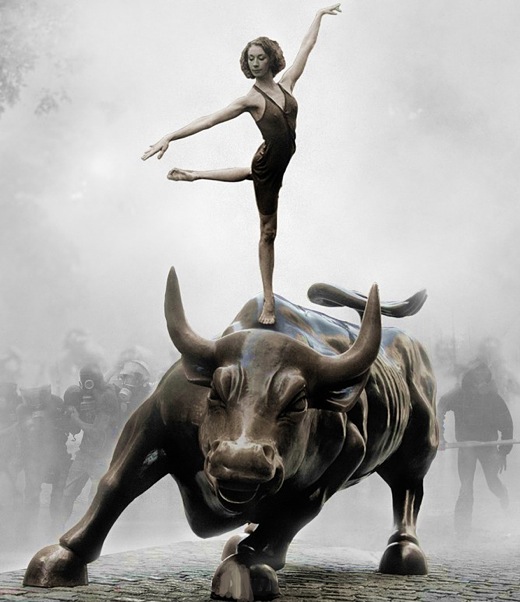
This is a look at the origin of the Occupy Wall Street movement, a counter-history of the rebel imaginary. It describes how artists, graphic novelists, digital activists and the decline of political marketing helped create the Occupy epiphany.
Everything starts with an image printed on July 18, 2011 by the radical magazine Adbusters depicting a bull, symbolizing Wall Street, and a dancer, symbolizing virtue and grace living in the most violent crisis of capitalism since 1929. The dancer tames the bull without reins, using only the touch of a foot. The beast swings, kicks. The dancer, unperturbed, remains on the back. It works like a charm, for the animal seems to give way under the gentle but unyielding pressure of the foot. Behind, the tear gas and the gas masks of the activists emerge.
The image – both the foreground and the background – is significant. For example, a similar image surfaced in Seattle in 1999, the year the anti-globalization movement was born, during the first episode of resistance and combat against global capitalism. The foreground of that symbolic image was the gas mask of an activist surrounded by flames. Again, both the foreground and background were significant. The symbol of the WTO emerges from the fog of tear gas in the background.
The new image clearly has a distinct political background: The enemy is still financial capital, embodied in its true symbol, the bull. Its opponent is a woman, embodying virtue and art, who spends her life hanging in a precarious balance. All of this is welded together in the same image. The bull and the dancer represent the inseparability of the conflict between lightness and heaviness, grace and bestiality, work that is alive and dead labor, productivity and speculation. As for everything else, it is evident that the context remains the same: clashes with the police, tear gas, fire, explosions – all the things we’ve seen from Greece to Egypt, as well as in Italy since 2008.
The image that became a symbol of Occupy Wall Street has been attributed to an anonymous person by the Vancouver-based Canadian magazine Adbusters, which specializes in “cultural jamming” – that is, subvertising and radically critiquing consumerism and global capitalism. It appeared on the net a few hours after July 18, 2011.
On that day, Adbusters proposed the peaceful occupation of Wall Street in order to protest the interference of multinational corporations, banks and rating agencies in democracy as well as their roles in the global financial crisis.
The idea was to change how political movements communicated.
In an interview with the magazine Link last October, Micah White, senior editor of Adbusters, explains the strategy: “The theoretical model for Adbusters has been to avoid traditional, market-tested models of engagement to get people interested. Instead,” White explained, “We rely on passionate words, pertinent facts and beautiful art to try to provoke epiphanies! That’s what it’s all about!”
The bull and the dancer can therefore be considered an epiphany of the present.
In the early hours after the release of the image, Adbusters was joined by Alexa O’Brien, IT strategist for U.S. Day of Rage, one of the focal points in the creation of the campaign. Alexa, who has an Irish father and a Slavic mother and was born in Seattle and raised by her mother in New York, founded the grassroots movement U.S. Day of Rage. Its fundamental slogan is reminiscent of the American revolution: “One citizen. One dollar. One vote.”
The epiphany has given off energy in no time. Daniel O’Brien, brother of Alexa, a graphic artist in his 30s, has reinvented the traditional Spartacan iconography of the Industrial Workers of the World and, more generally, of the labor movement, for Occupy Wall Street, adding some stylistic features to socialist realism.
This happened before the peaceful occupation of Zuccotti Park in New York on Sept. 17, 2011. The appeal of Adbusters has been read 20,000 times between July and September, and it is likely that many of the people who did it were present at the demonstration. The hashtag #Occupy came out only on Sept. 16, a phenomenon launched by the Twitter account newyorkerist, which has issued 11,000 tweets.
In addition, the massive intervention of Anonymous, a lively and sharp transnational group of hackers, certainly served to promote and spread the movement’s appeal. The fact remains that most Americans, on Sept. 17, weren’t aware of Occupy Wall Street.
Let’s recap: In the beginning, we have an epiphany with the image of a bull and a dancer. After the intervention of Twitter and Facebook and with the help of U.S. Day of Rage, an idea was created using the iconographic tradition of socialist realism, the Industrial Workers of the World and Spartacanism, which already have a number of similarities. The initial epiphany, which retains the original idea, then extends in several aspects through the inspiration of a graphic novel by Alan Miller.
In October, there came the idea that completed the circle: Alan Miller and David Lloyd, who 30 years ago created the anti-totalitarian and anti-capitalist V for Vendetta, now support Occupy Wall Street. The epiphany was designed by artists and graphic novelists. Together, they created a book in support of the movement.
This is the amazing video announcing the collective book that the most famous American graphic novelists have made to finance the movement: http://www.youtube.com/watch?v=B6zFjUwDBpc.

Leave a Reply
You must be logged in to post a comment.